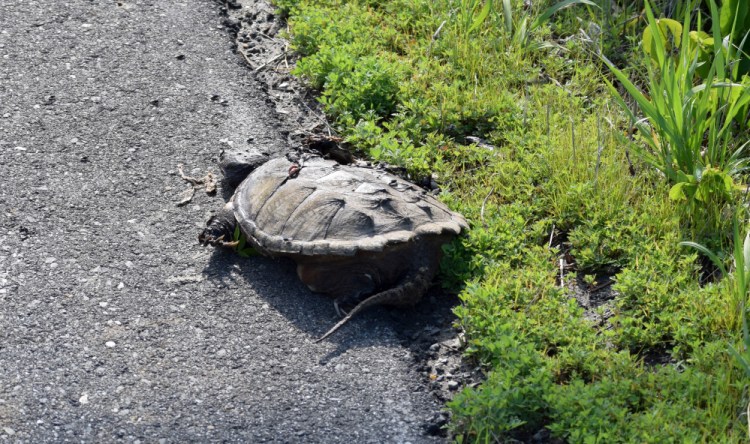Somebody ran over a big snapping turtle on Route 9 in Troy a couple of weeks ago.
You’d like to think it was an accident. But it didn’t look like it. When I drove by on my way to Unity, I saw the turtle pulling herself like a swamp thing out of the muck toward the pavement. When I drove back an hour later, she was crushed in the gravel a couple of feet from where I’d spotted her. The vehicle had to swerve off the pavement to hit the turtle.
What she was doing, no doubt, was making her way to a nesting site. Snappers (Chelydra serpentina), like other turtles, hibernate during the winter and start waking up hereabouts in May, mating time. In June, the females set out on their search for a spot to lay their eggs, which frequently takes them across roads. The ideal nesting area is a sandy, sunny spot near a stream — often near a dam or in a gravel pit — where the hatchlings, who come out in the fall, can live for a couple of years before moving to deeper water. The males, at least, spend pretty much their whole lives in the same area, while many, though apparently not all, females return to the same nesting sites cycle after cycle, according to herpetologist Susan Kynast on the Tortoise Trust website.
The only snag in the snapping turtle life cycle is that hardly any young turtles live. The nests get raided by predators like foxes and raccoons, and the hatchlings who survive incubation continue to be in danger when they crawl out searching for water to settle down in. The few in a thousand who actually grow up stop being food by the time their shells, or carapaces, are about 3 inches long. After that, the adult survival rate is more than 90 percent, according to Kynast. It’s thought that most snapping turtles who survive childhood live to be around 50. Some more than 75 have been observed, and some likely live much longer — theoretically up to 170.
Unless, that is, they get run over by a vehicle, which is practically their only direct threat.
Snapping turtles are the really big ones you see lumbering across the road in June — carapaces have been measured up to 18 inches — but others of Maine’s 10 turtle species listed in the UMaine Press book “Maine Amphibians and Reptiles” are doing the same thing at the same time and suffering the same roadkill fate. Maine lists two turtle species as endangered — Blanding’s turtle and the box turtle, whose ranges are the southwestern part of the state, according to the Department of Inland Fisheries and Wildlife. The spotted turtle, whose range runs roughly from western Hancock County south, skirting Penobscot, Somerset, Franklin and Oxford counties, is listed by Maine as threatened. The wood turtle is listed as a species of special concern.
One of the adults’ principal enemies is habitat disruptions caused by humans, especially in wetlands. Snapping turtles seem to be doing pretty well overall in Maine, so harvesting is legal as long as you kill the animal immediately (though their bodies store some serious toxins, so it’s inadvisable to eat them), and with a permit, you can legally collect the living beings.
But the other big threat to adult turtles is automobiles. You’d think swerving out to avoid a turtle would put a better shine on your day (not to mention keep the local ecology going) than swerving onto the roadside to crush one. You have a choice.
A friend some years ago was driving along U.S. Route 1A in Holden when she saw a huge snapping turtle crossing the road. Traffic was barreling down the hill at her, and she couldn’t go around. So she stopped. The turtle trundled slowly along, pausing occasionally to get its bearings.
In a few moments Joanna saw in her mirror flashing blue lights. The cop car pulled up behind her and the officer got out and asked her what she thought she was doing.
“Look,” Joanna said, and pointed to the turtle, certain she was in for an angry scolding and possibly a criminal summons.
The cop looked at the turtle for a few seconds, got back in his car, pulled around Joanna’s car, and blocked off the road, lights flashing. He got out and stopped traffic both ways, waited a few minutes for the turtle to cross, and then waved everybody along.
Life finds a way, to quote a monster movie, and sometimes you’re it. Or not.
Dana Wilde lives in Troy. You can contact him at naturalist1@dwildepress.net. Backyard Naturalist appears the second and fourth Thursdays each month.
Copy the Story LinkSend questions/comments to the editors.




Success. Please wait for the page to reload. If the page does not reload within 5 seconds, please refresh the page.
Enter your email and password to access comments.
Hi, to comment on stories you must . This profile is in addition to your subscription and website login.
Already have a commenting profile? .
Invalid username/password.
Please check your email to confirm and complete your registration.
Only subscribers are eligible to post comments. Please subscribe or login first for digital access. Here’s why.
Use the form below to reset your password. When you've submitted your account email, we will send an email with a reset code.